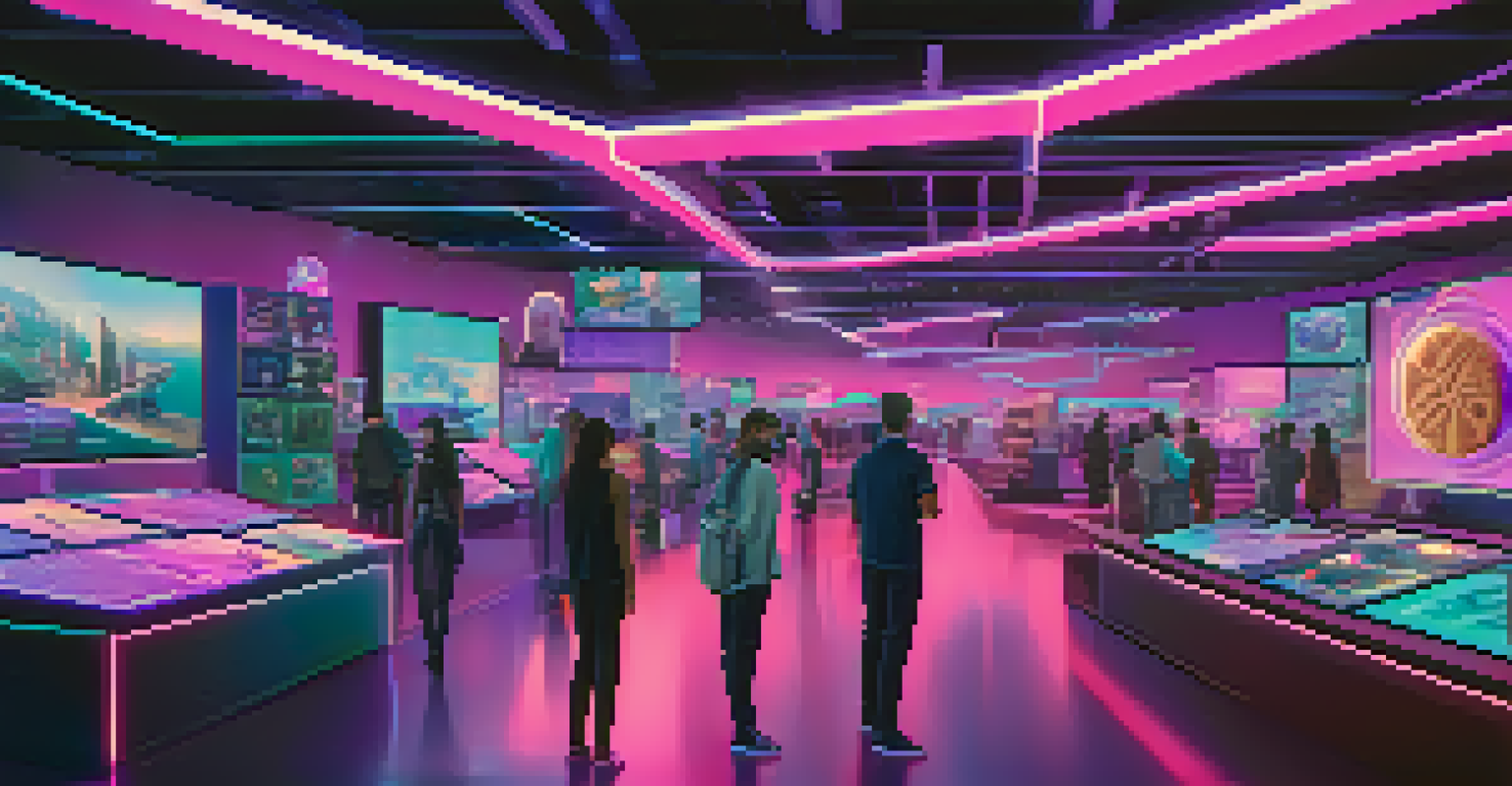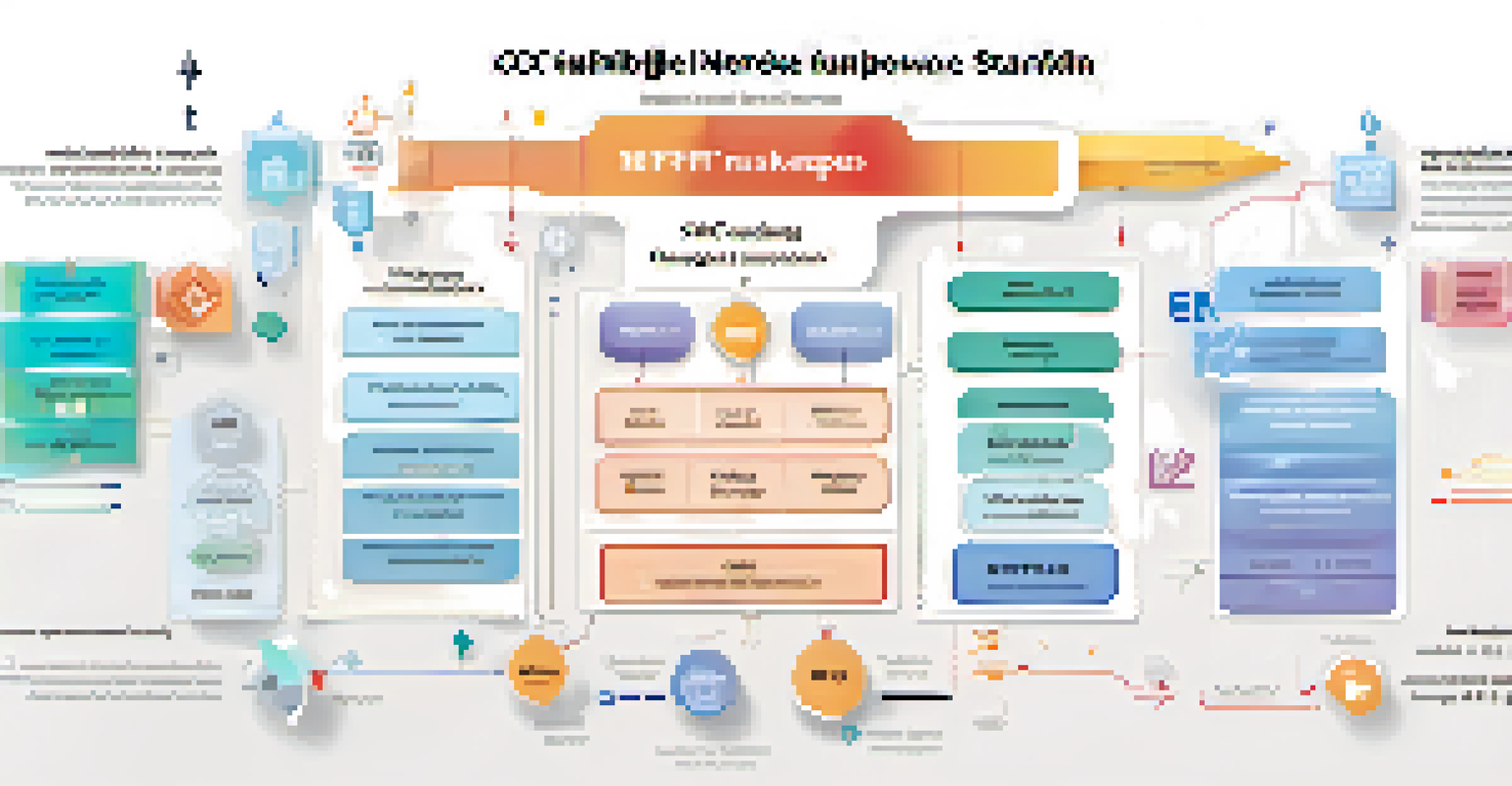Token Standards and Their Influence on NFT Marketplaces Today

Understanding Token Standards in the NFT Space
Token standards are essential protocols that define how tokens behave on a blockchain. In the context of NFTs, these standards ensure interoperability and provide a common framework for creating and managing digital assets. Common token standards like ERC-721 and ERC-1155 have emerged to cater specifically to the unique needs of non-fungible tokens.
The blockchain does not just provide a way to transfer value; it enables the creation of unique assets that can be owned, traded, and valued in new ways.
ERC-721 was the first standard for NFTs, allowing for the creation of one-of-a-kind tokens. This means each NFT can represent unique digital items, such as artwork or collectibles, making them distinct from cryptocurrency, which is interchangeable. On the other hand, ERC-1155 allows for both fungible and non-fungible tokens within a single contract, offering flexibility for developers and users alike.
Understanding these standards is crucial for anyone looking to navigate the NFT marketplace. They not only dictate how assets are created and transferred but also influence the overall user experience. As the NFT market evolves, staying informed about these standards can help buyers and sellers make smarter decisions.
The Role of ERC-721 in Shaping NFTs
ERC-721 is often regarded as the backbone of the NFT ecosystem. Introduced in 2017, this standard allows for the creation of unique tokens that can represent ownership of digital assets, such as art, music, or virtual real estate. Thanks to ERC-721, artists and creators can monetize their work in innovative ways that were previously unimaginable.

One of the standout features of ERC-721 is its ability to verifiably prove ownership and authenticity. This is particularly important in the art world, where provenance can significantly affect value. With blockchain technology, each NFT can have a transparent history, reassuring buyers about the legitimacy of their purchases.
Importance of Token Standards
Token standards like ERC-721 and ERC-1155 are crucial for defining token behavior, ensuring interoperability, and enhancing user experience in the NFT marketplace.
However, while ERC-721 has paved the way for NFTs, it also has limitations, such as higher gas fees for transactions. As the market grows, the need for more efficient standards has led to the exploration of alternatives that could enhance the user experience while maintaining the uniqueness of NFTs.
Exploring ERC-1155's Versatility in NFT Marketplaces
Enter ERC-1155, a groundbreaking token standard that offers a solution to some of the limitations of ERC-721. This standard allows developers to create multiple types of tokens—both fungible and non-fungible—within a single contract. This versatility can significantly streamline the development process for NFT projects, making it easier to manage various assets.
Interoperability is essential for the future of NFTs; it allows different platforms to recognize and trade the same digital assets seamlessly.
Imagine a game where players can buy, sell, and trade both unique weapons (NFTs) and in-game currency (fungible tokens) without having to interact with multiple contracts. ERC-1155 simplifies this by allowing all assets to be bundled together, enhancing the efficiency of transactions and reducing gas fees. This is a game-changer for developers and players alike.
As NFT marketplaces adopt ERC-1155, we may see a shift towards more complex and diverse digital ecosystems. This could lead to innovative new platforms that offer unique experiences combining different types of assets, ultimately enriching the user experience in the NFT space.
Impact of Token Standards on NFT Marketplace Functionality
Token standards significantly influence the functionality of NFT marketplaces. For instance, platforms built on ERC-721 generally focus on the uniqueness of individual assets, while those using ERC-1155 can cater to a wider variety of transactions. This flexibility can affect how users engage with the marketplace, shaping their buying and selling behaviors.
Marketplaces leveraging ERC-1155 can offer bundled assets, enabling users to purchase multiple items in one transaction. This feature not only enhances user convenience but also encourages more frequent trading. As a result, marketplaces can potentially see increased user engagement and transaction volume.
ERC-721 vs. ERC-1155
While ERC-721 focuses on unique NFTs, ERC-1155 offers versatility by allowing both fungible and non-fungible tokens within a single contract, streamlining transactions.
In contrast, platforms that strictly adhere to ERC-721 may excel in showcasing individual items but may struggle with user retention due to higher costs and less efficient transaction processes. Understanding these dynamics is crucial for both developers and users to choose the right platforms for their NFT activities.
The Growing Importance of Interoperability
Interoperability among NFT marketplaces has become increasingly important as the NFT ecosystem expands. Token standards like ERC-721 and ERC-1155 are instrumental in fostering this interoperability, allowing different platforms to recognize and trade the same digital assets. This capability enhances liquidity and provides users with more options.
For instance, if a user purchases an NFT on one marketplace, they should ideally be able to sell or showcase it on another without complications. This seamless experience is crucial for building trust and encouraging broader participation in the NFT market. As more marketplaces adopt common standards, the potential for collaboration and cross-platform trading will increase.
However, achieving full interoperability is not without challenges. Different marketplaces may implement standards in varied ways, leading to inconsistencies that can frustrate users. As the industry matures, ongoing dialogue among developers and platforms will be essential to ensure a truly interconnected NFT landscape.
Challenges and Limitations of Current Token Standards
While token standards have revolutionized the NFT marketplace, they also come with their own set of challenges. For example, ERC-721's focus on uniqueness can lead to issues like high gas fees, especially during peak transaction times. This can deter users from engaging with the marketplace, particularly those who are new or less experienced.
Moreover, the rapid growth of NFTs has led to an influx of projects that may not adhere to established standards, creating confusion among users. Some marketplaces may even support custom standards, which can complicate the trading process and hinder user experience. This inconsistency underscores the need for clearer guidelines within the NFT ecosystem.
Future of NFT Marketplaces
As technology evolves, we can expect new token standards that reduce transaction costs and cater to specific industries, ultimately enriching the NFT ecosystem.
As we look to the future, addressing these challenges will be critical. Innovations and improvements to existing standards, along with the development of new protocols, can help mitigate these issues and enhance the overall user experience in NFT marketplaces.
Future Trends in Token Standards and NFT Marketplaces
The future of token standards and their impact on NFT marketplaces is an exciting area to explore. With the continuous evolution of technology and user preferences, we can expect to see more sophisticated standards emerge. Innovations aimed at reducing transaction costs and improving user experience will likely be at the forefront of these developments.
Additionally, as more industries explore the potential of NFTs, we may witness the creation of specialized token standards tailored to specific sectors, such as gaming or real estate. These new standards could address unique needs and challenges, fostering a more vibrant and diverse marketplace.

Ultimately, the evolution of token standards will play a significant role in shaping the future of NFTs. By embracing innovation and collaboration, the NFT community can create a more inclusive and efficient marketplace that benefits creators, collectors, and users alike.